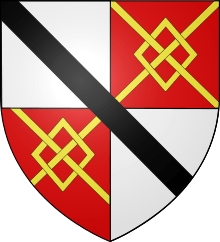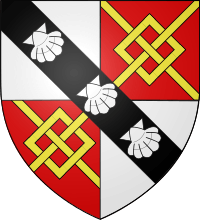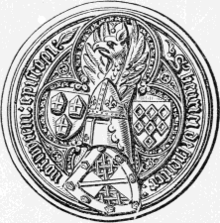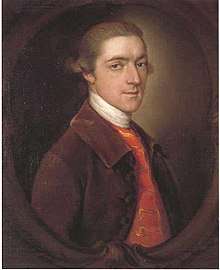Spencer (surname)
Spencer (also Spenser) is a surname, representing the court title dispenser, or steward. An early example is Robert d'Abbetot,[1][2][3] who is listed as Robert le Dispenser ('the steward'), a tenant-in-chief of several counties, in the Domesday Book of 1086. In early times the surname was usually written as le Despenser, Dispenser or Despencer—notably in works such as the Domesday Book and the Scottish Ragman Rolls of 1291 and 1296, but gradually lost both the "le" article and the unstressed first syllable of the longer surname to become Spencer.
| Pronunciation | spènser, /ˈspɛnsər/ spEnser |
|---|---|
| Origin | |
| Word/name | Medieval Latin dispensa and dispensator Old French – despensier Anglo-French – espenser Middle English – spens, spenser |
| Meaning | derived from the Old French despensier, a steward |
| Region of origin | England |
| Other names | |
| Variant form(s) | Spenser, Spender, Espencer, Spence, Spens |
As an occupational surname, Despenser/Spencer families would have originated in a range of different jurisdictions, and the possession of the shared surname is not an indication of genealogical relationship. The surname Spencer has gained in frequency over time. In the 19th century it also become popular as a given name—especially in the more anglicised areas of the United States.
Variations
English
In its transition from the French dispencier to its current form, the name Spencer has been presented and spelled in many ways—especially through the period of its early evolution in the medieval period from c.1100 to 1350 AD. The following (in alphabetical order) is a selection of the many orthographic variants:
Despencer,[4] de Expansa (derived from expence),[5] De Spencer, de Spendure,[6] de Spens, de la Despense,[6][7] De la Spence,[8] de la Spense,[6] del Spens,[6] Despenser,[4][9] DeSpenser, Dispencer,[10] Dispenser,[9] Despensator,[9] Dispensator,[10] la Spens, le Despencer,[10] le Despendur,[6] le Despencer,[11] le Despenser,[11][12] le dispencer, le Espencer,[13] le Espenser,[13] le Spencer,[14] le Spendur,[6] Spendure,[6] le Spenser,[14] le Spensier,[13] Spence,[6][10][15] Spences, Spen, Spens,[6][10] Spensar, Spense,[6] Spenser,[10] Spensers, Spensor, Spincer, also the rare patronymic Spencers,[6] and the aphetic (derived) Spender.[6]
The surnames Stewart and Stuart denote essentially the same occupation but have a completely different word derivation. They originate from the pre-7th-century English words stigweard—a compound of stig meaning household—and weard, a guardian.[16]
Other countries and cultures
Foreign Equivalents:
- German and Ashkenazic Jewish: Speiser – a steward. This is a derivative of the Middle High German spise, meaning food or supplies via the Old High German—in turn derived from Late Latin expe(n)sa (pecunia), or "(money) expended".
- Greek: Economos – the anglicised surname derived from the Greek oikonomos ("oi" in Greek pronounced as a long E.) Oiko- (English = ēco-) is a root meaning "house" in classical Greek. This surname has the same occupational derivation as Spencer but, like the surnames Stewart and Stuart, has a different etymology. The original meaning of oikonomos was a home owner but it evolved to mean estate manager, somebody who was responsible for all resources on the estate, a steward. Oikonomos was a medieval Eastern Roman title for somebody who was in charge of a project or institution; it is still used by the Greek Orthodox church. Over time the meaning of Oikonomos has evolved from "manager of resources" to "manager of money, a treasurer".
Etymology
The name Spencer can be traced through its Latin and French roots to its Middle English and modern form.[17]
- Medieval Latin – dispensa, dispensator and dispensarius – steward.
- Old French –
- a. despense – larder
- b. espenser, -ier – dispenser of money, provisions etc.; someone working at, or in charge of, the buttery; a household steward
- c. despendour – steward.
- Anglo-French – despenser, -ier.
- Middle English – dispensour – steward.
Noteworthy Despenser and Spencer families
Robert Despenser
Robert d'Abbetot [nb 1] was granted titles, lands and a high position in William's court. In addition to his position as steward he also was given land grants in county Bedford. He held his office for the period c.1088–1098.[18]
In England, Robert was best known by his occupation, and hence became known as Robert le Despenser (many spelling variants of this name exist including Robert the Dispensor, Robert Despensator,[9] Robert Dispenser[19]), which reflected his new official position,[20] of using a patronymic, as Robert fitzThurstin.[18] He seems to have maintained his favor with William because in the Domesday Book of 1086, Robert Despenser was listed as a land tenant-in-chief in Gloucestershire, Leicestershire, Lincolnshire, Oxfordshire, and Warwickshire, as well as holding lands in Worcestershire obtained from the Bishop of Worcester.[18]
Robert is assumed to have died shortly after restoring some estates to Westminster Abbey[18] but he appears to have had no legitimate male children, as his heir was his brother Urse d'Abetot.[21] He may have had a daughter, as some of his lands were inherited by the Marmion family, but it is also possible that a daughter of Urse married into the Marmion family.[20] Robert's office as the king's steward may also have gone to Urse, as it was later held by Urse's heirs. A later steward, Thurstin, might have been an illegitimate son of Robert.[22] Subsequent bearers of the Despenser or Spencer surname would not descend from Robert.
King's Dispensers
The steward of William II of England was Thurstan, Dispensator Regis (royal steward). His son Hugh was Dispensator Regis in 1105 under Henry I, and was followed by his son or brother, Simon, Dispensator Regis for Henry and Stephen. Simon was father of a second Thurstan, who was active in the 1250s under Henry II, to be followed by his son Walter as Dispensator Regis. Walter was succeeded by his brother Aymer, Dispensator Regis under king John, and Aymer's son Thurstan le Despenser, who served under Henry III, dying in 1249. He was followed by a son, Adam le Despenser, who was summoned by Edward I of England to perform military service and in 1283 to attend on the king in what was a precursor to the first royally-convened Parliament. His heir was a son, Aymer le Despenser, but he alienated his lands and titles during the reign of Edward II.[23][24][25]
Lords Despencer

In the early 13th century, a family that had been stewards to the Earls of Chester rose to prominence.[26] Hugh le Despenser (died 1238) became High Sheriff of Berkshire, and his son, Hugh became Justiciar of England and was summoned in 1264 to the Parliament of Simon de Montfort as Lord Despencer. His son also named Hugh was created Earl of Winchester, while a descendant was made Earl of Gloucester. The family experienced a number of attainders, restorations, and creations of new lordships over the 13th and 14th centuries, with a claim to the last creation passing by marriage to the Wentworth family in the 15th century. The initial establishment was brought out of abeyance in favour of a female-line descendant in 1604, from which time the title of Baron le Despencer has descended to the current Viscount Falmouth.
Spencer aristocracy

The English aristocratic Spencer family has resided at their ancestral home at Althorp, Northamptonshire, since the early 16th century. The Estate now covers 14,000 acres (57 km2) in Northamptonshire, Warwickshire and Norfolk. From pre-Tudor times the Spencers had been farmers, coming to prominence in Warwickshire in the 15th century when John Spencer became feoffee of Wormleighton in 1469, and a tenant at Althorp in 1486. His nephew, another John, used the gains from trade in livestock and commodities to buy both properties. He was knighted in 1504 and died in 1522. John's descendants expanded the family holdings through business dealings and marriage into the peerage. The family is related through marriage to the Churchills of Blenheim Palace, a line that included the Dukes of Marlborough and Winston Churchill. From the Althorp line came the Earls of Sunderland, the later Dukes of Marlborough, and the Earls Spencer. The family captured international attention when Lady Diana Frances Spencer married Prince Charles on 29 July 1981, and her death in a car crash in Paris on 31 August 1997.[27]
Heraldry
The varied origins of people with the Spencer and Despenser surnames means that they are not all members of the same family, and each individual family would have distinct coats of arms, while most Spencers are not entitled to bear any arms. The family of the King's Dispensers bore an ermine shield with chief of unknown tincture.[23] The Lords Despencer bore arms from the early days of heraldry, which are one of a family of quarterly arms seen among the vassals of the Earls of Chester. Scholars have suggested a possible derivation from those of the Dutton family,[28] or from the family of their one-time feudal overlords, Beauchamp of Bedford, whose own arms belonged to a shared group of similar bearings among Mandeville and Vere family vassals and descendants.[29] They are described in the language of heraldry as quarterly: 1st & 4th, Argent; 2nd & 3rd, Gules a fret or, over all a bend sable. In 1504, John Spencer of Althorp was granted for himself and his brother the arms: azure, a fess ermine between six sea-mews' heads erased argent, and in 1564 a descendant of his uncle was granted: sable, on a fess or, between 3 bezants, as many lions heads of the first. As the end of the century approached, however, the family's growing social status would lead them to adopt a forged pedigree that gave them an ancient derivation, and they began using new arms that represented a claimed kinship with the (actually entirely unrelated) Lords Despencer, modifying the earlier family's quarterly arms by the addition of three escallops (scallop shells).[30] Numerous variations of this differenced coat, along with various Spencer arms bearing no resemblance to those of the Lords le Despenser, have been catalogued.[31]
Notable Spencers
- The following is a small selection of notable Spencers.
13th century
- Hugh le Despenser (sheriff) (died 1238) was a wealthy land owner in the East Midlands of England, as well as High Sheriff of Berkshire.
- Sir Hugh le Despencer (justiciar), Baron le Despencer (1223–1265) son of sheriff Hugh was an important ally of Simon de Montfort during the reign of Henry III. He served briefly as Justiciar of England (Chief Justice) in 1260 and as Constable of the Tower of London and the castles of Shrewsbury, Bruges, and Balsover.
- Hugh le Despenser, 1st Earl of Winchester (1262–1326) the elder Despenser, was for a time the chief adviser to King Edward II of England.
- Hugh Despenser the Younger (1286–1326) became Royal Chamberlain in 1318 and the favourite of Edward II of England but developed a reputation for greed and, after falling out with the Barons, was accused of treason. He was forced into exile in 1321 with his father, who later fled to Bordeaux. Hugh was captured and sentenced to public execution by hanging (for thievery), and drawing and quartering (for treason).
14th century

- Edward le Despenser (1310–1342) was the third eldest son of Hugh le Despenser the Younger by his wife Eleanor de Clare.
- Edward le Despencer, 1st Baron le Despencer, KG (also called Despenser) (c. 24 March 1335 or 1336 – 11 November 1375) was the son of Edward le Despenser (1310–1342) and Anne, the sister of Henry, Lord Ferrers of Groby. He succeeded as Lord of Glamorgan in 1349.
- Henry le Despenser (c. 1341–1406), Bishop of Norwich
- Thomas le Despenser, 1st Earl of Gloucester (22 September 1373 – 13 January 1400, Bristol) was the son of Edward le Despenser, 1st Baron le Despencer, whom he succeeded in 1375.
- Richard le Despenser, 4th Baron Burghersh (1396–1414) was the son and heir of Thomas le Despenser, 1st Earl of Gloucester (1373–1400)
16th century
- John Spencer (1524–1586), owner of Althorp and MP
- Edmund Spenser (c. 1552 – 13 January 1599) was an English poet best known for The Faerie Queene, an epic poem celebrating—through fantastical allegory—the Tudor dynasty and Elizabeth I. He is recognized as one of the premier craftsmen of Modern English verse in its infancy.
17th century
- Col. Nicholas Spencer (1633–1689) was an English merchant born at Cople, Bedfordshire, who emigrated to the Colony of Virginia, where he served as land agent for his cousin Thomas Colepeper, 2nd Baron Colepeper. A planter with extensive landholdings, Spencer later served in the Virginia House of Burgesses, as Secretary and President of the Council of the Virginia Colony, and as Acting Governor. With his friend John Washington, Col. Spencer patented the Mount Vernon estate land grant.
18th century

by Thomas Gainsborough
- John Spencer (1734–1783), 1st Viscount Spencer and 1st Earl Spencer
19th century
- Sir Walter Baldwin Spencer KCMG (23 June 1860 – 14 July 1929) was a British-Australian biologist and anthropologist.
- Herbert Spencer (27 April 1820 – 8 December 1903) was an English philosopher, prominent classical liberal political theorist, and sociological theorist of the Victorian era.
20th century
- Elizabeth Spencer (soprano), recording artist for Thomas Alva Edison
- Percy Spencer (1894–1970), American inventor of the microwave oven
- Unity Spencer (1930–2017), British artist
- Diana, Princess of Wales, (Diana Frances; née Spencer; 1961–1997), first wife of Charles, Prince of Wales.
- Lady Kitty Spencer (born 1990), English model
Distribution and spread
The greatest density of Spencers in present-day England is in Nottinghamshire, followed by Derbyshire. Derby and Notts were closely connected at the time of Domesday, and up until the time of Elizabeth I had the same Sheriff.[32]
In North America early settlement of Spencers date to Thomas Spencer in Virginia in 1623; William Spencer, Cambridge, Massachusetts in 1630; Thomas Spencer, Maine 1630. Col. Nicholas Spencer arrived in Virginia in the 1650s and subsequently served as Acting Governor.
Spencers arriving in Australia with the convicts of the First Fleet in 1788 were Daniel Spencer from Dorchester, John Spencer, and Mary Spence from Wigan.[33] With the Third Fleet in 1791 came John Spencer from Lancaster and Thomas Spencer from London.[34]
See also
- Spencer (disambiguation)
- Spencer's (disambiguation)
- Spence (surname)
- Spenser
- Spens (disambiguation)
Footnotes
- Robert's toponymic, d'Abbetot, indicates his place of origin, the present-day Normandy village of St-Jean-d'Abbetot. In the historical literature his name, and that of the village, are spelled and presented in many ways including d'Abitot, d'Abetot, Dabitote, d'Abbetot, d'Arbitot and d'Albeto: the "d" is sometimes capitalised or anglicised to "of".
References
- See Round, 2004.
- Barlow, 1983, pp. 141–142.
- Arthur, 1857, p. 238.
- Reaney and Wilson, p. 132.
- Weekley, 1917 p. 106.
- Reaney and Wilson, p. 420.
- Ragnam rolls
- Bardsley, 1875 p. 209.
- Keats-Rohan, p. 383.
- Lower, 1860. p. 325.
- Bardsley, 1875 p. 542.
- Thuresson, p. 117.
- Thuresson, p.118.
- Bardsley, 1875 pp. 209, 598.
- Bardsley, 1875 p. 598.
- Reaney and Wilson, p. 427.
- Lewis, p.420.
- Barlow 1983, pp. 141–142.
- Mason, p. 75.
- Round, Abetot, Urse d' (c.1040–1108).
- See Barlow
- Mason, p. 141.
- George Edward Cokayne (1916), New Complete Peerage, 4, London: The St Catherine Press, pp. 287–8
- William Farrer (1923), Honors and Knights' Fees, 1, London: Spottiswoode, Ballantyne & Co., pp. 258–9
- J. Horace Round (1911), The King's Serjeants & Officers of State, London: James Nisbet & Co., pp. 186–197
- George Edward Cokayne (1916), New Complete Peerage, 4, London: The St Catherine Press, p. 259
- "Althorp Estate visitor information". Archived from the original on 26 May 2009. Retrieved 18 September 2018.
- John Gouch Nichols (1853), "Genealogical Declaration Respecting the Family of Norres, Written by Sir William Norres, of Speke, co. Lancaster, in the Year 1563: Accompanied by an Abstract of Ancient Charters", The Topographer and Genealogist, 2: 370
- Round, J. Horace (1901), Peerage and Family History, Winchester: Archibald Constable & Co., p. 329
- Round, Peerage and Family History, 1901, pp. 279–329
- Bernard Burke (1884), The Armory General of England, Scotland, Ireland and Wales, London: Harrison, pp. 953–4
- Barlow, M. p. 8.
- Convicts of First Fleet. Transcript from London Gazette", October 1788.
- Convicts of the Third Fleet
Bibliography
- Anderson, William 1863. The Scottish Nation (Volume 3: MAC to ZET). Edinburgh: A. Fullerton & Co. Retrieved 22 August 2009.
- Arthur, William 1857. An Etymological Dictionary of Family and Christian Names With an Essay on their Derivation and Import. New York: Sheldon, Blake, Bleeker & Co. Retrieved 28 April 2010.
- Barber, Henry 1894. British Family Names : Their Origin and Meaning, With Lists of Scandinavian, Frisian, Anglo-Saxon and Norman names. London: E. Stock.
- Bardsley, Charles W. 1875. English Surnames : Their Sources and Significations. London: Chatto and Windus. Retrieved 26 August 2009.
- Bardsley, Charles W. 1991. Our English Surnames: Their Sources and Significations. London: Chadwyck-Healey Ltd.
- Barlow, Montague 1935. Barlow Family Records. London: Bemrose. Retrieved 22 August 2009.
- Barlow, Frank 1983. William Rufus. Berkeley: University of California Press. ISBN 0-520-04936-5.
- Black, George F. 1946. The Surnames of Scotland: their Origin, Meaning and History. New York: New York Public Library. Retrieved 26 August 2009.
- Boutelle, Charles 1867. English Heraldry. London: Cassell, Petter & Galpin. Retrieved 26 August 2009.
- Brooke-Little, John 1973. An Heraldic Alphabet. London: Macdonald.
- Burke, John 1838. A Genealogical and Heraldic History of the Commoners of Great Britain and Ireland. Vol. IV. London: Henry Colburn. Retrieved 23 August 2009.
- Connolly, Matthew F. 1866. Biographical Dictionary of Eminent Men of Fife ... Edinburgh: Inglis & Jack. Retrieved 23 August 2009.
- Fox-Davies, Arthur C. 1909. The Complete Guide to Heraldry. London: T. C. & E. C. Jack.
- Keats-Rohan, Katharine S. B. 1999. Domesday People: A Prosopography of Persons Occurring in English Documents, 1066–1166: Domesday Book. Ipswich: Boydell Press. ISBN 0-85115-722-X.
- Jobling, Mark A. 2001. "In the Name of the Father: Surnames and Genetics" Trends in Genetics 17(6): 353–357. Retrieved 23 May 2010.
- Lewis, Robert E. 1989. Middle English Dictionary. Ann Arbor: University of Michigan Press. ISBN 0-472-01202-9.
- Lower, Mark A. 1859. English Surnames. An Essay on Family Nomenclature, Historical, Etymological and Humorous. 3rd edn. Vol. 1. London: John Russell Smith. Retrieved 26 August 2009.
- Lower, Mark A. 1860. Patronymica Britannica: A Dictionary of Family Names of the United Kingdom. London: John Russell Smith. Retrieved 22 August 2009.
- Mason, Emma 2005. William II: Rufus, the Red King. Stroud: Tempus. ISBN 0-7524-3528-0.
- Newman, Charlotte A. 1988. The Anglo-Norman Nobility in the Reign of Henry I: The Second Generation. Philadelphia: University of Pennsylvania Press. ISBN 0-8122-8138-1.
- Nicolas, Nicholas H. 1827. A Chronicle of London, From 1089 to 1483; Written in the Fifteenth Century, and for the First Time Printed from MSS. in the British museum. London: Longman, Rees, Orme, Brown and Green. Retrieved 26 August 2009.
- Reaney, Percy H. and Wilson, Richard M. 2005. Oxford Dictionary of English Surnames. Oxford: Oxford University Press. ISBN 978-0-19-280663-5.
- Round, John Horace 2004. Abetot, Urse d' (c.1040–1108). rev. Emma Mason. In Oxford Dictionary of National Biography. Oxford: Oxford University Press. (fee required). Retrieved 26 August 2009.
- Thuresson, Bertil 1950. Limited view Middle English Occupational Terms Lund: Gleerup. Retrieved 26 August 2009.
- Weekley, Ernest 1914. The Romance of Names. London: John Murray. Retrieved 26 August 2009.
- Weekley, Ernest 1917. Surnames. London: John Murray.
- Woodward, John. 1896. A Treatise on Heraldry, British and Foreign: with English and French glossaries. Volumes I & II. California: W. and A. K. Johnston, University of California. Revised version Woodward, John and Burnett, George. 1969. Virginia: C.E. Tuttle, University of Virginia. Retrieved 26 August 2009.
- Wright, Thomas 1864. The Roll of Arms, of the Princes, Barons, and Knights who Attended King Edward I to the Siege of Caerlaverock, in 1300. London: John Camden Hotten. Contains account of Hugh le Despencer, the younger and the older and their coat of arms. Retrieved 26 August 2009.
External links
| Look up Spencer in Wiktionary, the free dictionary. |
- Genealogy
- Spencer Historical & Genealogical Society web site. (Society based in America.)
- Spencer Genealogy Forum
- DNA lineages
- History
- Peerage